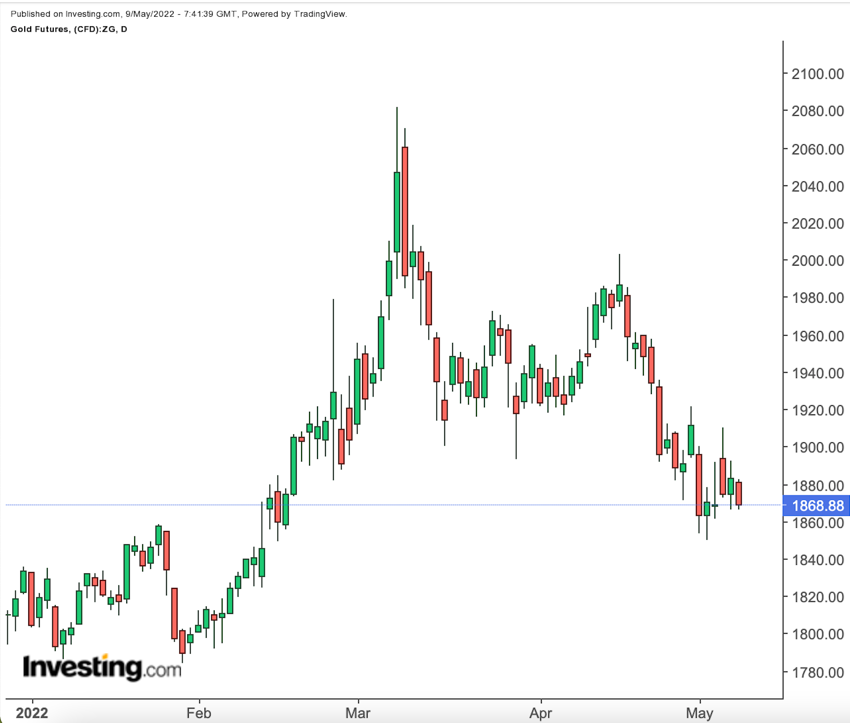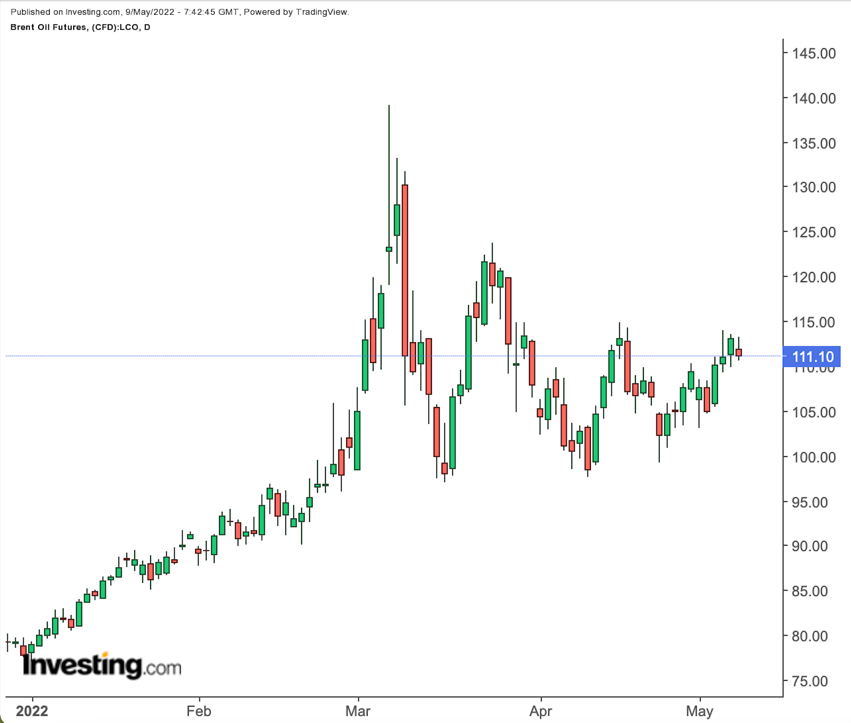Fears of a global recession from high inflation and resultant monetary tightening by central bankers could determine if oil prices come off their peaks this week, allowing gold to climb instead as an insurance to economic troubles.
Wednesday’s monthly reading for the US Consumer Price Index (CPI), will show whether inflation in the world’s largest economy has peaked after months of growing at its fastest pace in four decades. If so, the Federal Reserve might be prompted not to impose shockingly-high rate hikes in the coming months.
If not, markets fear the Fed’s next recourse might be a 75 basis-point hike, after last week’s 50 bps increase—already the highest in more than 20 years.
The Fed insists that its rate hikes will not tip the US economy into recession but the markets aren’t buying that for now.
While crude futures had risen against the past two weeks, sending pump prices of US gasoline to fresh record highs this weekend, fear of an unhinged Fed and what that could do to the economy could ignite another selloff in oil this week, analysts say.
Oil slipped earlier on Monday on fears of a global recession before turning higher with investors eying European Union talks on a Russian oil embargo that is expected to tighten global supplies.
Speculation that Russian President Vladimir Putin could raise the Ukraine conflict to the level of “war” in conjunction with Moscow’s Victory Day celebrations today—versus the “special military operation” tag he used so far—also kept crude prices generally supported.
Chinese economic data also aided the rebound, despite recent fears of COVID lockdowns that had depressed oil prices.
China’s year-on-year exports fell from 14.7% to 3.9% in April, versus a forecast growth of 3.2%. But imports year-on-year were flat from an expected decline of 3% and a previous negative growth of 0.1%. Consequently, the trade balance itself was at $51.12 billion versus a forecast of $50.65 billion and a previous figure of $47.38 billion.
Brent crude, the London-traded global benchmark for oil, was up 39 cents, or 0.4%, at $112.78 a barrel by 12:51 AM ET (0451 GMT) after touching a session low of $110.64. 
Brent had gained 6% over two previous weeks after the May meeting of OPEC+ agreed to a standard production hike of 432,000 barrels per day that once again fell short of the market’s supply-demand.
New York-traded West Texas Intermediate (WTI), the benchmark for US crude, was up 28 cents, or 0.3%, at $110.05. It had declined earlier to $110.64.
WTI rose just over 8% in two previous weeks.
Notwithstanding the recent rebound in crude prices, the threat of a recession could still do oil in, said analysts.
“The Fed looks increasingly belligerent where rates are concerned and this could spook sentiment across, beginning with stocks right through to oil,” said John Kilduff, founding partner at New York energy hedge fund Again Capital.
Jeffrey Halley, who heads Asia-Pacific research for online trading platform OANDA, also said crude prices might have difficulty breaking beyond their recent barrier without significant upside risks in the Ukraine conflict.
“Brent crude has formed a triple top at $114.75 a barrel, which will be a formidable barrier in the near term. Support lies at $103.50 a barrel and I am sticking to my broader $100 to $120 a barrel wider range ahead for now,” Halley said.
“WTI has resistance at $111.50 with support at 100.00 a barrel,” he explained, adding.
“Once again, I remain comfortable with a $95 to $115 a barrel outlook in the medium term.”
After the fifth consecutive weekly decline in global equities and bonds, futures of the S&P 500 and NASDAQ 100 contracts fell over 1% in Monday’s Asian trading as Japan led Asian stock markets lower, and sovereign debt was under pressure.
A flurry of speeches by Fed policymakers this week could further raise the bar for monetary tightening by the central bank.
Richmond Fed President Tom Barkin had already turned the hawkish bar a notch higher by Friday by saying he was “not ruling out support for a 75-bps hike”.
Central bank officials slated to give their thoughts on rates and the economy this week include Atlanta Fed President Raphael Bostic, New York Fed President John Williams, Fed Governor Christopher Waller, Minneapolis Fed President Neel Kashkari, Cleveland Fed President Loretta Mester and San Francisco Fed President Mary Daly.
Additional impetus to oil downside could come from the relentless rally in the dollar, which at nearly 20-year highs is already causing some demand destruction in energy. The Dollar Index, which pits the greenback against six other major currencies, is up almost 11% on the year.
In gold’s case, the front-month gold futures for June on New York’s COMEX settled up $7.10 at $1,882.80 per ounce in Friday’s trade. Even so, June gold fell 1.5% on the week, sliding for a third week in a row in a decline that set the yellow metal back by almost 5% altogether for the period.
Gold tumbled as the dollar—its key rival and chief beneficiary of US rate hikes—soared along with bond yields led by the US 10-year Treasury note. The Dollar Index, which pits the greenback against six currency majors, rose to a peak of 104.12, its highest since the December 2002 mark of 107.38.
“There are some constructive notes in gold’s recent price action,” said OANDA’s Halley.
“It is holding up remarkably well versus a rampant US dollar and a U.S. (bond) yield curve where a lot of it starts with three in yield terms.”
Disclaimer: Barani Krishnan uses a range of views outside his own to bring diversity to his analysis of any market. For neutrality, he sometimes presents contrarian views and market variables. He does not hold positions in the commodities and securities he writes about.
